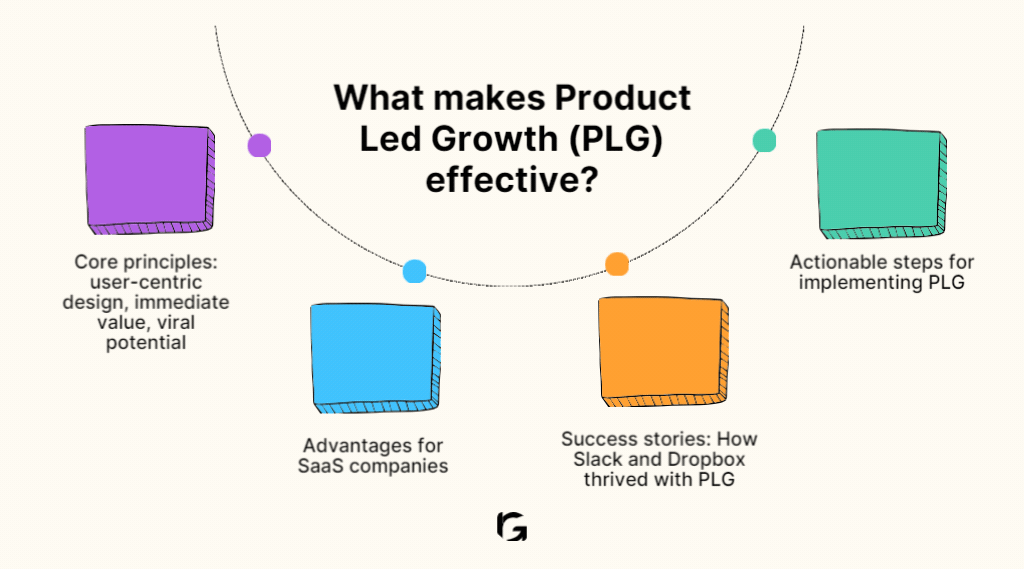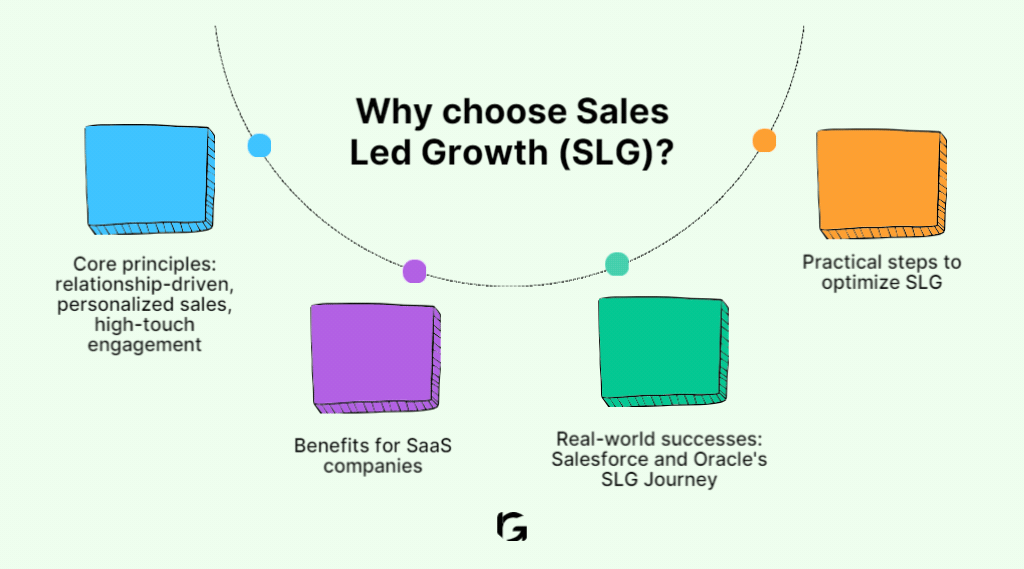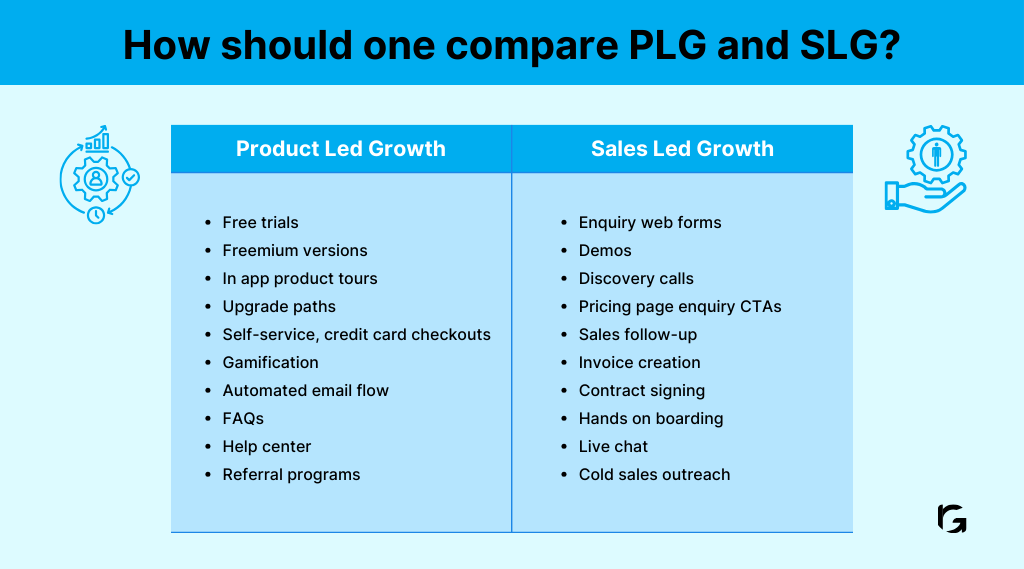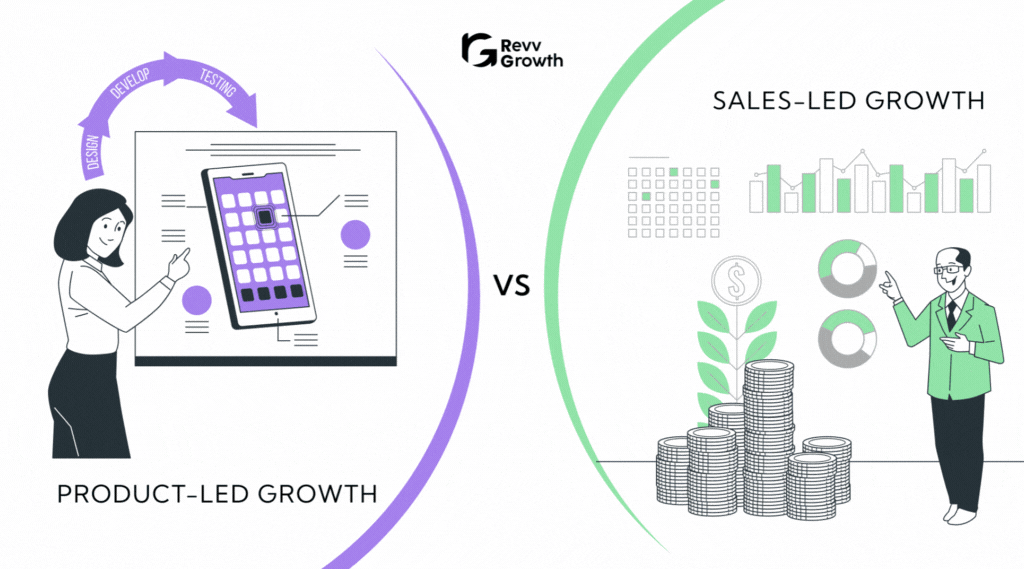Introduction
As a SaaS founder, you face the constant challenge of choosing the right path to grow your business. With user experience at the heart of your software solution, deciding between Product-Led-Growth (PLG) and Sales-Led-Growth (SLG) can be daunting. How do you ensure your product stands out and attracts loyal users? How do you balance the need for a seamless user experience with effective sales strategies?
PLG lets your product be the star, driving adoption through its merits and usability. SLG, meanwhile, emphasizes personal connections and tailored solutions through a dedicated sales team. Both strategies have their merits, but which aligns best with your goals? This blog examines details of PLG and SLG, helping you make an informed decision that will drive your business forward.
What makes Product Led Growth (PLG) effective?
Product-led growth (PLG) shines because it prioritizes the user experience. But what exactly makes PLG so effective? Let’s explore:

Core principles: user-centric design, immediate value, viral potential
First, PLG is all about user-centric design. This means creating a product that’s intuitive and easy to use. Users should find value right from the start without needing much guidance. Think about the last time you used a product that just “clicked” – that’s what we aim for. Immediate value is crucial. Users who see the benefits quickly are likelier to stick around. And don’t forget the viral potential. Happy users love to share great products with others, driving organic growth.
Advantages for SaaS companies
So, why should SaaS companies care? For starters, PLG is cost-efficient. A large sales team isn’t necessary when your product does most of the work. This also means you can see rapid adoption as users easily get started and spread the word. Plus, when your product consistently delivers value, user retention goes up.
Success stories: How Slack and Dropbox thrived with PLG
Look at Slack and Dropbox for inspiration. Slack’s easy-to-use interface and smooth integration made it popular for team communication. Users loved it so much that they recommended it to their colleagues. Dropbox did something similar with its simple file-sharing capabilities. Users found it so helpful they invited others, driving growth without a big sales push.
Actionable steps for implementing PLG
Want to implement PLG? Start by designing a product that’s easy to use and solves a real problem. Offer a free trial or a basic free version to attract users. Listen to user feedback and keep improving. And make sure your product has features that encourage sharing and referrals. When your product is genuinely great, it’ll start to sell itself.
Why choose Sales Led Growth (SLG)?

Core principles: relationship-driven, personalized sales, high-touch engagement
Sales Led Growth (SLG) is about building strong, personal customer relationships. Imagine having a sales team that gets to know each customer, understands their unique needs, and offers tailored solutions. This high-touch approach means your sales team guides each potential customer through the buying process, ensuring they feel valued and understood. It’s about adding that human touch, which can be very effective, especially for complex or high-value sales.
Benefits for SaaS companies
So, why should SaaS companies consider SLG? First, it allows for tailored solutions. Your sales team can customize offerings to meet specific customer needs, which is crucial for products requiring detailed explanations or custom integrations. Second, SLG opens up opportunities for upselling. As your sales team builds relationships, they can identify additional needs and suggest complementary products or upgrades. Finally, strong customer relationships often lead to higher loyalty and long-term retention. When customers feel valued and understood, they’re more likely to stick with your product and recommend it to others.
Real-world successes: Salesforce and Oracle’s SLG Journey
Salesforce and Oracle show how effective SLG can be. Salesforce’s personalized approach helps businesses find what they need within its vast range of products. Oracle relies on a knowledgeable sales force to guide clients through their options.
Practical steps to optimize SLG
To make SLG work, invest in a well-trained sales team that knows your product inside and out. Provide them with tools and data to personalize their approach. Use a CRM system to track customer interactions and preferences. Encourage your sales team to listen actively and adapt their strategies. This relationship-driven approach can enhance customer satisfaction, boost sales, and drive long-term growth.
How should one compare PLG and SLG?

| Aspect | Product Led Growth (PLG) | Sales Led Growth (SLG) |
| Acquisition Strategies | Users discover and adopt the product on their own. | The sales team reaches out, explains, and persuades potential customers. |
| Customer Experience | Self-serve model: users can try and use the product independently. | Personalized touchpoints: salespeople provide demos and tailored solutions. |
| Scalability and Cost | Cost-efficient and scalable; product handles growth with minimal extra cost. | Resource-intensive; scaling requires more salespeople, increasing costs. |
| Cultural Impact | Creates a product-centric culture focused on continuous improvement. | Fosters a sales-oriented culture driven by targets and relationship-building. |
| Operational Needs | Heavy reliance on user data and analytics for product improvements. | Requires strong coordination between sales, marketing, and support teams. |
Which growth strategy fits your SAAS company?
Assessing PLG suitability
To determine if Product Led Growth (PLG) is right for your SaaS company, consider the following:
- Simplicity and Ease of Use: Is your product intuitive and easy for users to understand without help?
- Immediate Value Delivery: Does your product provide noticeable benefits quickly?
- Viral Growth Potential: Can users easily share and recommend your product to others?
Assessing SLG suitability
To see if Sales Led Growth (SLG) fits your company, evaluate these aspects:
- Product Complexity and Customization Needs: Does your product require detailed explanations or custom setups?
- Necessity of Personalized Solutions: Do customers need tailored solutions to meet their specific needs?
- High-Touch Sales Process Requirements: Is a personal, hands-on sales approach essential for closing deals?
Key factors to consider when choosing between PLG and SLG
When deciding between PLG and SLG, consider your target audience and product characteristics. If your product is straightforward and can deliver value quickly, PLG might be the way to go. It’s efficient and can scale easily as your user base grows. However, SLG may be more effective if your product is complex and requires a customized approach. This strategy allows you to build strong relationships and provide tailored solutions, which can be crucial for higher-value sales.
Additionally, consider your company’s resources. PLG requires robust product development and user analytics, while SLG demands a skilled sales team and effective CRM systems. When choosing the best growth strategy for your business goals and capabilities, weigh these factors carefully.
How can you embrace a hybrid model?
The advantages of merging PLG and SLG strategies
Think about merging the strengths of both Product-Led Growth (PLG) and Sales-Led Growth (SLG). A hybrid model lets you harness the efficiency and scalability of PLG while also benefiting from the personalized touch of SLG. This means your product can attract users independently, and your sales team can step in to offer tailored solutions when needed. It’s like having a product that sells itself and a team ready to help with the finer details.
Core principles of Product-Led Sales (PLS)
In a Product-Led Sales (PLS) approach, your product is still the star, driving initial interest and engagement. But when users have specific needs or require more complex solutions, your sales team is there to provide personalized support. It’s about giving users the best of both worlds: the ease of a great product and the support of a knowledgeable sales team.
Practical integration steps
- Align teams: Make sure your marketing, sales, and product teams are on the same page. Regular meetings and common goals can be helpful.
- Leverage data: Use data from your product to spot engaged users who might need extra help. This way, your sales team can focus on already interested users.
- Tailor approaches: Offer a self-serve option for users who prefer to explore independently and personalized sales support for those who need it.
- Continuous feedback: Get feedback from both your sales team and your users. This will help you keep improving your product and your sales approach.
How Can Sales Insights Enhance PLG?
- Improving user onboarding and support
- Leveraging sales data for product development
- Balancing self-serve and sales-assisted growth
Improving user onboarding and support
Sales insights are a goldmine for enhancing Product Led Growth (PLG). Your sales team knows exactly where new users struggle. Use this feedback to refine your onboarding process and support materials, making it easier for users to get started and see value quickly.
Leveraging sales data for product development
Sales data reveals what features users crave and what they love most about your product. This helps your product team focus on updates that genuinely matter, ensuring your product evolves to meet user needs.
Balancing self-serve and sales-assisted growth
Some users love the self-serve model, while others need more help. Sales insights help you spot who needs extra support, so you can offer a mix of self-serve and personalized assistance, ensuring everyone has a great experience.
Learning from case studies and real-world Examples: HubSpot
- Detailed analysis of successful transitions
- Outcomes of hybrid model implementations
- Actionable insights and lessons for SaaS companies
- Actionable insights and lessons for SaaS companies
Detailed analysis of successful transitions
Let’s talk about HubSpot, a company that successfully blended Product-Led Growth (PLG) with Sales-Led Growth (SLG). Initially, HubSpot relied heavily on its sales team to drive growth, offering personalized demos and solutions. As the market evolved, HubSpot realized it needed a more scalable approach to attract and engage users directly through the product.
Outcomes of hybrid model implementations
By adopting a hybrid model, HubSpot introduced a free version of its product, allowing users to sign up and start using it without any sales interaction. This move significantly increased user acquisition. Meanwhile, the sales team focused on converting free users into paying customers, offering personalized upgrades and solutions. This combination boosted HubSpot’s growth, improving user acquisition and conversion rates.
Actionable insights and lessons for SaaS companies
HubSpot’s success teaches us a few key lessons. Offering a free tier can dramatically increase user sign-ups. Using sales insights to identify promising users lets your sales team focus their efforts effectively. And finally, continuously gathering feedback helps refine your product and sales approach. Balancing PLG and SLG can drive growth and improve customer satisfaction. This approach ensures you meet user needs while scaling efficiently, leading to sustainable success.
Conclusion
Choosing the right growth strategy for your SaaS company is a big decision. Whether you choose product-led Growth (PLG), Sales-Led Growth (SLG), or a mix of both, each has its strengths.
PLG lets your product shine, attracting users with its ease of use and immediate value. SLG builds deep relationships through personalized solutions. A hybrid approach can give you the best of both worlds, combining scalability and personal touch.
Keep gathering feedback and refining your approach. The right strategy will help you scale, meet customer needs, and succeed. Are you ready to take your SaaS to the next level?
RevvGrowth helps B2B SaaS businesses grow, generate demand, adopt the right marketing strategies, track performance and critical growth metrics, and stay competitive while maximizing revenue.
Take your B2B SaaS business to new heights. Reach out to our experts and start your journey towards greater success.
FAQs
1. What is product-led growth vs sales-led growth?
– Product-led growth (PLG) focuses on using the product to drive user acquisition and growth, while sales-led growth (SLG) relies on a sales team to convert leads into customers.
2. What are the three pillars of product-led growth?
– The three pillars of PLG are a great user experience, a self-service model, and data-driven insights to continuously improve the product.
3. Where does sales fit in a PLG world?
– In a PLG world, the sales team often assists high-value or enterprise customers who need more personalized support, bridging the gap between self-service and tailored solutions.
4. How do PLG companies measure success?
– PLG companies measure success through user engagement metrics, such as active users, feature usage, and customer retention rates.
5. What types of companies benefit most from SLG?
– Companies with complex products or those targeting large enterprises benefit most from SLG, as these often require detailed explanations and personalized sales efforts.


